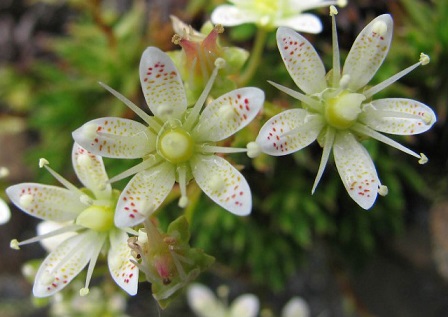Proanthocyanidins and methyl gallic acid glucoside from Saxifraga plants exhibit virucidal properties
Nikhil Prasad Fact checked by:Thailand Medical News Team Jul 02, 2024 1 year, 5 months, 4 days, 20 hours, 12 minutes ago
Herbs And Phytochemicals: In the quest to combat viral infections, nature often provides hidden treasures. Among these are the Saxifraga plants, a group of species known for their unique beauty and, as recent studies suggest, potent antiviral properties. Researchers have been delving into the chemical constituents of five Saxifraga species to uncover their potential in fighting viruses like influenza A (IAV), SARS-CoV-2, feline calicivirus (FCV), and murine norovirus (MNV).
 Proanthocyanidins and methyl gallic acid glucoside from Saxifraga plants exhibit virucidal properties
Image - Saxifraga spinulosa
The Saxifraga Species
Proanthocyanidins and methyl gallic acid glucoside from Saxifraga plants exhibit virucidal properties
Image - Saxifraga spinulosa
The Saxifraga Species
The genus Saxifraga consists of approximately 400 species, celebrated for their striking flowers and diversity. In Japan, Saxifraga stolonifera, S. fortunei, S. nipponica, S. cortusifolia, and S. rebunshirensis are popular as ornamental plants. However, their use extends beyond aesthetics; in traditional medicine, particularly in East Asia, these plants have been employed to treat a variety of ailments ranging from burns and frostbite to whooping cough and eczema.
Discovery of Antiviral Compounds
Recent research by scientists from Tohoku Medical and Pharmaceutical University-Japan, has turned the spotlight on Saxifraga plants' antiviral capabilities. For example, Saxifraga spinulosa, a medicinal plant from Mongolia, has shown promise in inactivating multiple viruses, including SARS-CoV-2. This spurred further investigation into the antiviral properties of other Saxifraga species.
The
Herbs And Phytochemicals study focused on isolating and identifying chemical compounds from these plants that could combat viral infections. Proanthocyanidins, a type of condensed tannin, emerged as common and potent antiviral agents among these species.
The Experimental Journey
The Japanese study team conducted extensive experiments to isolate and test the chemical compounds from the Saxifraga species. They employed advanced techniques such as nuclear magnetic resonance (NMR) spectroscopy and mass spectrometry to identify the structures of these compounds. Among the isolated substances were 30 distinct compounds, including a methyl gallic acid glucoside and a flavonol glycoside, both previously undescribed.
Testing the Virucidal Activity
The isolated compounds were then tested for their virucidal activities against IAV, SARS-CoV-2, FCV, and MNV. While none of the compounds matched the virucidal strength of Saxifraga species-derived tannins, some showed significant activity compared to the negative control, dimethyl sulfoxide (DMSO). Specifically, compounds 13 and 17 demonstrated effectiveness against IAV, while compounds 9, 14, and 17
were active against SARS-CoV-2. For FCV and MNV, compounds 7, 9, 13, 14, and 17 showed promising results.
The Significance of the Findings
Despite the relatively weaker virucidal activity of the new compounds compared to the tannins, these findings are crucial. They highlight the potential of Saxifraga plants as a source of antiviral agents. Notably, the presence of galloyl groups in the compounds appears to play a key role in their virucidal activity, consistent with previous studies.
These results support the idea that natural products, like those derived from Saxifraga species, could be valuable in developing new antiviral treatments. The study's authors suggest that while the new compounds alone may not be as potent as tannins, their chemical characteristics can inform the development of more effective antiviral agents.
Future Directions
The journey of exploring Saxifraga plants' antiviral properties is far from over. Researchers aim to continue their investigation, focusing on refining the extraction and isolation processes to uncover more potent antiviral compounds. They also plan to study the mechanisms through which these compounds exert their effects, which could lead to new therapeutic strategies against viral infections.
In conclusion, the study of Saxifraga plants opens up exciting possibilities in the realm of antiviral research. These plants, celebrated for their beauty, also hold promise as nature's virus fighters. As researchers delve deeper into their chemical makeup, we may find new ways to harness their potential in the fight against some of the most challenging viral infections of our time.
The study findings were published on a preprint server and are currently being peer reviewed.
https://papers.ssrn.com/sol3/papers.cfm?abstract_id=4853728
For the latest on
Herbs and Phytochemicals, keep on logging to Thailand Medical News.
Read Also:
https://www.thailandmedical.news/news/herbs-and-phytochemicals-beta-escin-from-aesculus-hippocastanum-is-a-broad-spectrum-antiviral-against-coronaviruses-including-sars-cov-2
https://www.thailandmedical.news/news/herbs-and-phytochemicals-polysaccharide-extracts-of-prunella-vulgaris-inhibits-herpes-simplex-virus-infection-by-blocking-tlr-mediated-nf-kb-activatio
